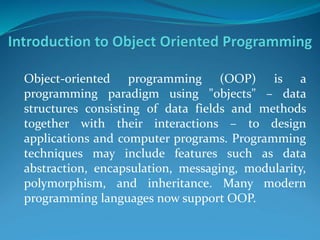Introduction to Object Oriented Programming.2.ppt
- 1. Object-oriented programming (OOP) is a programming paradigm using "objects" – data structures consisting of data fields and methods together with their interactions – to design applications and computer programs. Programming techniques may include features such as data abstraction, encapsulation, messaging, modularity, polymorphism, and inheritance. Many modern programming languages now support OOP.
- 2. A programming paradigm is a fundamental style of computer programming. Paradigms differ in the concepts and abstractions used to represent the elements of a program (such as objects, functions, variables, constraints, etc.) and the steps that compose a computation (assignment, evaluation, continuations, data flows, etc.).
- 3. In object-oriented programming, a class is a construct that is used as a blueprint to create instances of the class (class instances, class objects, instance objects or just objects). A class defines constituent members which enable class instances to have state and behavior. Data field members (member variables or instance variables) enable a class object to maintain state. Other kinds of members, especially methods, enable a class object's behavior. Class instances are of the type of the associated class. For example, an instance of the class "Fruit" (a "Fruit" object) would be of the type "Fruit". A class usually represents a noun, such as a person, place or (possibly quite abstract) thing. Programming languages that include classes as a programming construct subtly differ in their support for various class-related features. Most support various forms of class inheritance. Many languages also support advanced encapsulation control features, such as access specifiers.
- 4. Object is an run time entity. Is an Instance of class Represents a Place ,Person ,anything that have some attributes.
- 5. There is a very important distinction between an object and an instance of an object. An object is actually a definition, or a template for instances of that object. An instance of an object is an actual thing that can be manipulated. For instance, we could define a Person object, which may include such member data as hair color, eye color, height, weight, etc. An instance of this object could be "Dave" and Dave has values for hair color, eye color, etc. This allows for multiple instances of an object to be created.
- 6. A superclass, base class, or parent class is a class from which other classes are derived. The classes that are derived from a superclass are known as child classes, derived classes, or subclasses. In object-oriented programming (OOP), inheritance is a way to compartmentalize and reuse code by creating collections of attributes and behaviors called objects which can be based on previously created objects.





